

Ninjutsu. Karate. Karate (空手?)
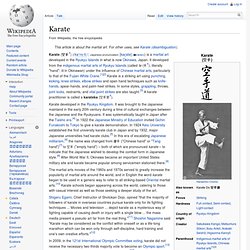
(/kəˈrɑːtiː/; Japanese pronunciation: [kaɽate] ( Karate developed in the Ryukyu Kingdom. It was brought to the Japanese mainland in the early 20th century during a time of cultural exchanges between the Japanese and the Ryukyuans. It was systematically taught in Japan after the Taisho era.[4] In 1922 the Japanese Ministry of Education invited Gichin Funakoshi to Tokyo to give a karate demonstration.
In 1924 Keio University established the first university karate club in Japan and by 1932, major Japanese universities had karate clubs.[5] In this era of escalating Japanese militarism,[6] the name was changed from 唐手 ("Chinese hand" or "Tang hand")[7] to 空手 ("empty hand") – both of which are pronounced karate – to indicate that the Japanese wished to develop the combat form in Japanese style.[8] After World War II, Okinawa became an important United States military site and karate became popular among servicemen stationed there.[9] History[edit]
Comparison of karate styles. The table contains a comparison of karate styles.
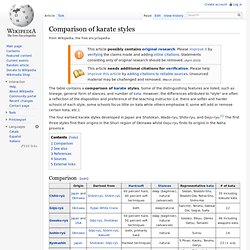
Some of the distinguishing features are listed, such as lineage, general form of stances, and number of kata. However, the differences attributed to "style" are often a reflection of the disposition and preference of the teaching instructor (i.e. there are softer and harder schools of each style, some schools focus little on kata while others emphasise it, some will add or remove certain kata, etc.).
Kyokushin kaikan. Kyokushin (極真?)

Enshin kaikan. Enshin kaikan (円心会館?) Is a style of "full contact karate", or Knockdown karate, founded in 1988 with dojo and students in various countries around the world. The core emphasis in Enshin is use of the Sabaki Method, a system of techniques employed with the goal of turning an opponent's power and momentum against him or her and repositioning oneself to the opponent's "blind" spot to counterattack from a more advantageous position. Although Enshin is a "stand-up fighting" style that includes kicks, strikes, and punches found in most other styles of karate, it also utilizes numerous grabs, sweeps, and throws often associated with Judo or other grappling styles of martial arts. Enshin was founded by Jōkō Ninomiya who directs the Enshin organization from the honbu in Denver, Colorado.
Shotokan Karate-Do. Jujutsu. Jujutsu (/dʒuːˈdʒuːtsuː/; Japanese: 柔術, jūjutsu listen , Japanese pronunciation: [ˈdʑɯɯ.dʑɯ.tsɯ]) is a Japanese martial art and a method of close combat for defeating an armed and armored opponent in which one uses no weapon or only a short weapon.[1][2] The word jujutsu can be spelled as ju-jitsu/jujitsu, ju-jutsu.
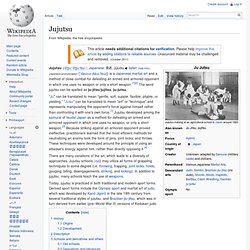
"Jū" can be translated to mean "gentle, soft, supple, flexible, pliable, or yielding. " "Jutsu" can be translated to mean "art" or "technique" and represents manipulating the opponent's force against himself rather than confronting it with one's own force.[1] Jujutsu developed among the samurai of feudal Japan as a method for defeating an armed and armored opponent in which one uses no weapon, or only a short weapon.[3] Because striking against an armored opponent proved ineffective, practitioners learned that the most efficient methods for neutralizing an enemy took the form of pins, joint locks, and throws. Daitō-ryū Aiki-jūjutsu. Daitō-ryū Aiki-jūjutsu (大東流合気柔術?) , originally called Daitō-ryū Jujutsu (大東流柔術, Daitō-ryū Jūjutsu?) , is a Japanese martial art that first became widely known in the early 20th century under the headmastership of Takeda Sokaku.
Takeda had extensive training in several martial arts (including Kashima Shinden Jikishinkage-ryū and sumo) and referred to the style he taught as "Daitō-ryū" (literally, "Great Eastern School"). Although the school's traditions claim to extend back centuries in Japanese history there are no known extant records regarding the ryū before Takeda. History. The Beginning "Where did it all begin?
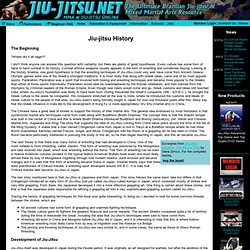
" I don't think anyone can answer this question with certainty, but there are plenty of good hypotheses. Every culture has some form of hand to hand combat in its history. Combat without weapons usually appears in the form of wrestling and sometimes boxing. Looking at the history timeline, one good hypothesis is that the wrestling techniques of Jiu-Jitsu could very well have come from Ancient Greece. Aikido. Modern Japanese martial art Aikido (合気道, aikidō, Japanese pronunciation: [aikiꜜdoː], kyūjitai: 合氣道) is a modern Japanese martial art developed by Morihei Ueshiba as a synthesis of his martial studies, philosophy and religious beliefs.
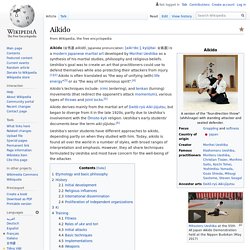
Ueshiba's goal was to create an art that practitioners could use to defend themselves while also protecting their attackers from injury.[1][2] Aikido is often translated as "the way of unifying (with) life energy"[3] or as "the way of harmonious spirit".[4] Mitsuteru Ueshiba at the 55th All Japan Aikido Demonstration held at the Nippon Budokan (May 2017) Aikido derives mainly from the martial art of Daitō-ryū Aiki-jūjutsu, but began to diverge from it in the late 1920s, partly due to Ueshiba's involvement with the Ōmoto-kyō religion. Ueshiba's early students' documents bear the term aiki-jūjutsu.[6] Ueshiba's senior students have different approaches to aikido, depending partly on when they studied with him. Etymology and basic philosophy[edit] Judo. History and philosophy[edit] Early life of the founder[edit] The early history of judo is inseparable from its founder, Japanese polymath and educator Jigoro Kano (嘉納 治五郎, Kanō Jigorō?
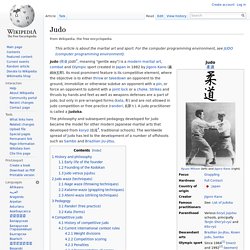
Kuzushi. The wooden sword is no longer an effective weapon since the attacker's balance has been compromised Kuzushi (崩し:くずし?)
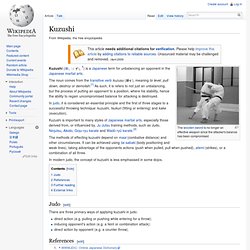
Is a Japanese term for unbalancing an opponent in the Japanese martial arts. The noun comes from the transitive verb kuzusu (崩す), meaning to level, pull down, destroy or demolish.[1] As such, it is refers to not just an unbalancing, but the process of putting an opponent to a position, where his stability, hence the ability to regain uncompromised balance for attacking is destroyed.
In judo, it is considered an essential principle and the first of three stages to a successful throwing technique: kuzushi, tsukuri (fitting or entering) and kake (execution). Atemi-Waza - Vital Point Striking.